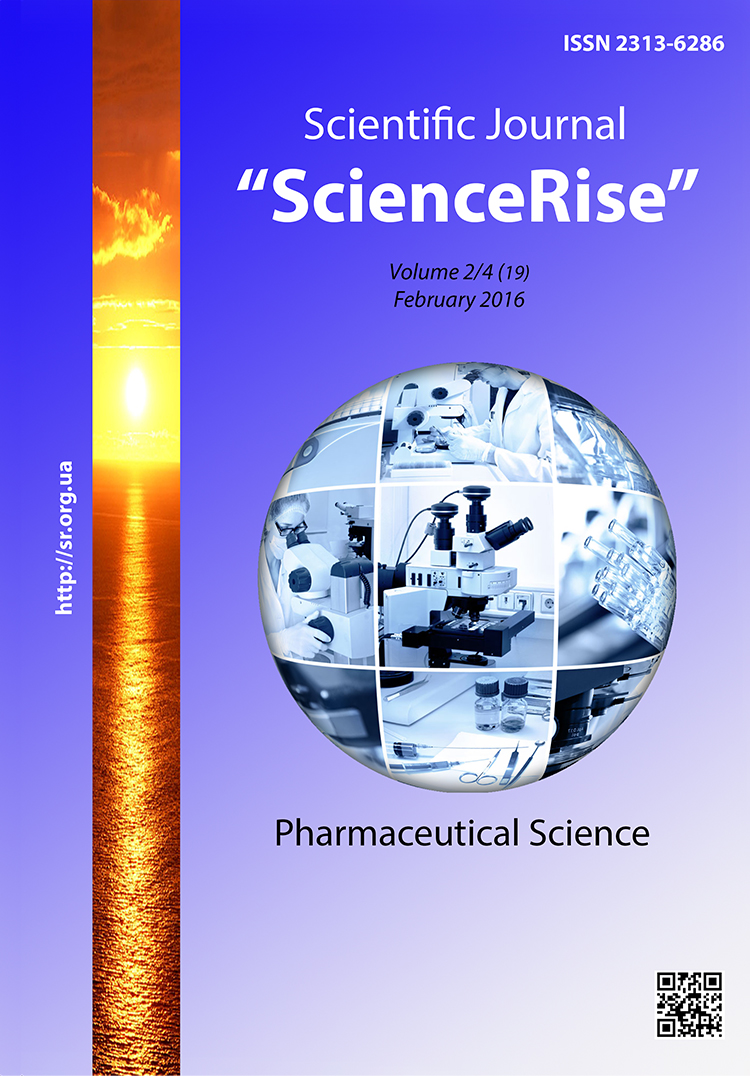Research in correlations between morphological features and chemical markers of species of genus Asperula L.
DOI:
https://doi.org/10.15587/2313-8416.2016.62313Keywords:
morphological features, chemotaxonomy, flavonoids, coumarines, iridoids, corelation, genus Asperula, RubiaceaeAbstract
The search of prospective sources of biologically active compounds (BAC) remains an important commitment of Pharmaceutical science. One of most effective methods of the search today is chemotaxonomy.
Aim. The aim of this study was the establishment of correlations between morphologic features of 16 species of genus Asperula L. of family Rubiaceae Juss. and their certain chemical markers.
Methods. Previous research identified 177 morphological features and ecological characteristics of the given species. Identified by means of chromatography in the herb of the species under study were a number of chemical compounds related to flavonoids, coumarins and iridoids.
Results. Established is the corelation between the morphological features of genus 16 species of genus Asperula L.: A. odorata, A. arvensis, A. humifusa, A. Besseriana, A. aparine, A. rivalis, A. tinctoria, A. tyraica, A. campanulata, A. galioides, A. octonaria, A. cynanchica, A. supina, A. Stevenii, A. rumelica, A. praevestita and the presents in the herb of theese species of flavonoids – cosmosiine, isoroifoline, cynaroside, luteoline-7-arabinosylglucoside, hyperoside; coumarin umbeliferone; iridoids – asperuloside, asperulosidic acid, scandoside and monotropeine.
Conclusions. Within the 16 species of the genus Asperula it was established that the presence of BAC correlates with only a limited number of morphological features, namely: quadrangular stems; leaves with a sharp short apex, linear-lanceolate, rough with fine spreading hairs along the midrib and margins, pointed towards the apex; inflorescences apical; corolla white, four-lobes.
The data obtained can be used for a targeted search of BAC in the species of genus Asperula L.
References
Borisov, M. I., Zoz, I. G. (1975). K hemotaksonomii vidov Asperula L. Rastitel'nye resursy, XI (1), 52–59.
Delprete, P. G., Choze, R., Silva, R. A., Dufrayer, C. R. (2006). Chemotaxonomy and macroclassification of Rubiaceae. Botan. Belg., 40, 28.
Mongrand, S., Badoc, A., Patouille, B., Lacomblez, C., Chavent, M., Bessoule, J.-J. (2005). Chemotaxonomy of the Rubiaceae family based on leaf fatty acid composition. Phytochemistry, 66 (5), 549–559. doi: 10.1016/j.phytochem.2004.12.021
Taskova, R., Mitova, M., Evstatieva, L. et. al (1997). Iridoids, flavonoids and terpenoids as taxonomic markers in Lamiaceae, Scrophulariaceae, and Rubiaceae. Bocconea, 5, 631–636.
Saleh, N. A. M. (1979). The biosynthesis of flavonoid glycosides and their importance in chemosystematics. Biochemical Systematics and Ecology, 7 (1), 37–45. doi: 10.1016/0305-1978(79)90039-5
Young, M. C. M., Braga, M. R., Dietrich, S. M. C. et. al (1996). Chemosystematic markers of Rubiaceae. Opera Bot. Belg., 7, 205–212.
Mitova, M. I., Anchev, M. E., Handjieva, N. V., Popov, S. S. (2002). Iridoid patterns in Galium L. and some рhylogenetic considerations. Zeitschrift fur Naturforschung C, 57 (3-4), 226–234. doi: 10.1515/znc-2002-3-405
Wilson, R. D. (1984). Chemotaxonomic studies in the Rubiaceae 2. Leaf flavonoids of New Zealand coprosmas. New Zealand Journal of Botany, 22 (2), 195–200. doi: 10.1080/0028825x.1984.10425251
Il'i'na, T. V. (2015). Farmakognostychne doslidzhennja roslyn rodyny Rubiaceae ta perspektyvy i'h vykorystannja v medycyni. Kharkiv, 42.
Jurchenko, N. S. (2015). Farmakognostychne doslidzhennja vydiv rodu Asperula L. Flory Ukrai'ny. Kharkiv, 24.
Downloads
Published
Issue
Section
License
Copyright (c) 2016 Тетяна Василівна Ільїна

This work is licensed under a Creative Commons Attribution 4.0 International License.
Our journal abides by the Creative Commons CC BY copyright rights and permissions for open access journals.
Authors, who are published in this journal, agree to the following conditions:
1. The authors reserve the right to authorship of the work and pass the first publication right of this work to the journal under the terms of a Creative Commons CC BY, which allows others to freely distribute the published research with the obligatory reference to the authors of the original work and the first publication of the work in this journal.
2. The authors have the right to conclude separate supplement agreements that relate to non-exclusive work distribution in the form in which it has been published by the journal (for example, to upload the work to the online storage of the journal or publish it as part of a monograph), provided that the reference to the first publication of the work in this journal is included.

